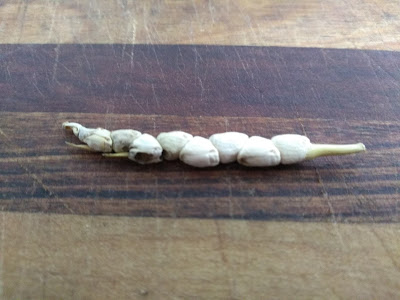STEP 1 - first time set up
Your mould has come complete, if this is the first time you are using your mould you will need to do two things.
1)
poke a hole for the wick. This can be achieved using a bamboo skewer
or a large needle. I use a needle so I can thread the wick through at
the same time. Somehow, like magic wax never drips out of this hole.
2)
you may need to slit the side of your mould to make release easier. If the mould has
detail that will get stuck, I slit the side using a craft knife/stanley
knife. You will also need a rubber band to hold the mould together. Note: If you don't think the candle will get stuck in the mould then don't cut it.
STEP 2 - collect your things
Collect everything need:
Weigh out 40 to 50 grams of organic beeswax
Your silicone mould
The correct size rubber band
Double saucepan or some other way to melt wax (NOT on direct heat)
Large needle or bamboo skewer
Baking paper
STEP 3 - melt the beeswax
WARNING: NEVER allow wax to come into
direct contact with a heat source. Beeswax has a low flash point (where it spontaneously ignites) and burns fiercely. If over heated beeswax discolours. Always be careful when dealing with heat/fire.
 |
| Beeswax chunks, in a pan over boiling water |
 |
| Beeswax almost melted |
Set up your double saucepan, adding the wax to the inner pot and water in the outer pot. Heat this on your stove top to melt the beeswax. Heating
over boiling water prevents the beeswax from reaching flash point and
catching on fire.
I don't have a fancy double boiler, I use an old dish
and I float that on a pot of boiling water.
These are instructions for simple beeswax candles, I only use pure organic beeswax. These instructions do not cover adding essential oils, fragrances, colours, or anything else as that is more advanced. Gain skills making pure beeswax candles, then you can learn more complex things.
Put
some baking paper down where you plan to pour your moulds. This will
ensure than any wax that is dripped/spilled will be simple to collect
and use later. I use a piece of timber and sticky tape baking paper to
it.
STEP 4 - add candle wick and rubber band
 |
| Silicone moulds, wicks, and skewers |
During the melt process, prepare your mould. Poke the wick through the
wick hole that you made at step 1. I use a needle to do this but you
could poke it through using a kitchen skewer. You only need a little poking out
of what will become the top. Silicone is 'self sealing' so won't drip.
The
other end of the wick can be tied to something to keep it in the
centre, then snipped off. I tie a knot in it and poke a needle through the wick,
but you could use a pen or anything that will hold it in place while
the molten beeswax cools and hardens. I find using a needle is simple and when the candle has set I just ship off the wick below the knot.
Place a rubber band around your mould, this will hold it together and ensure nothing leaks out of the slit you put in at step 1.
STEP 5 - pour the wax
 |
| Beeswax poured into silicone cnadle moulds |
Put your mould on the baking paper before you pour anything. As you can see above, I spilled a little while pouring. This isn;t wasted, I can easily peel it off the baking paper and use it later.
Pour
the wax to the desired level - most moulds fill to the top, but you
could fill to a mm or two lower. Beeswax usually shrinks a little as it
cools. Make sure you have the mould level, it will be
easy to see if it
is not.
STEP 6 - allow to set
Leave the wax in the mould somewhere safe to cool and harden. Keep
out of reach of pets and children. You don't want hot wax to be
knocked over as it will cause burn injuries.
I leave them overnight, but you can remove them from the moulds a lot earlier if they have set and cooled. Don't put them in the fridge to speed up the cooling as this will cause your candle to crack.
STEP 7 - remove your fancy new candle from the mould
 |
| Finished beeswax candles |
Once the candle has cooled you need
to remove it from the mould. Remove whatever was holding the wick in
place, I normally just snip the wick off just below the needle I used at the base of the candle.
Remove
the rubber band, and gently loosen the candle from the mould. Once the
candle is loose you should be able to carefully remove it from the
mould. Be gentle, your mould is reusable and should be able to make hundreds of candles.
Trim the wick to 5mm to 7mm before lighting. Always light away from
drafts, keep on a fireproof surface, keep well way from flammable
materials/curtains/pets, never leave unattended while lit, always supervise children if they are near a lit candle, and be careful whenever dealing with fire. If in
doubt, don't light the candle.
STEP 8 - pretend to be humble
Marvel at the incredibly detailed organic beeswax candle you have hand
poured. Give one to a friend as a gift, then stand back and pretend to be modest
when they oooh and ahh over how incredibly talented you must be to have made such an amazing candle.
 |
My daughter made this owl beeswax candle (with help)
|




















































